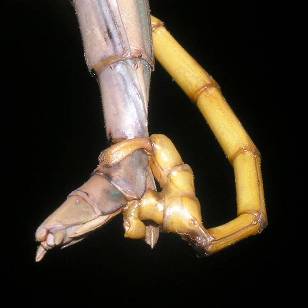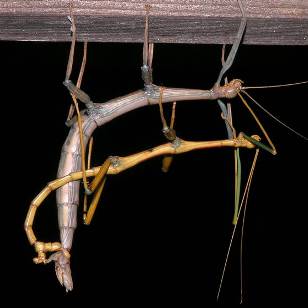
Reproduction
Mating Habits:
The mating habits of Megaphasma
dentricus appear to follow no predictable patterns. The
males show no preference for female size, and instead mate with
who they come in contact with first. Differing from other
species of phasmids, which fight for access to females, males of
this species do not compete with each other (Maginnis 2008).
When a male decides to mate with an available female, he will
approach her, wrap his clasping organs (link to form page)
around her last abdominal segment, and hang from her (Wilkins
1951). The male can usually attach to the female in two minutes,
and will stay attached for at least twelve hours. A male who has
achieved this position will never abandon the female, even if
another male attempts to clasp on while they are paired. These
second males are referred to as ‘loser’ males, and are
unsuccessful in their attempts at mating. Although they are
usually too far away from the genitalia and frequently slip off
of the female, the ‘loser’ males spend ninety percent of their
time trying to pair. Individuals of Megaphasma dentricus
usually have a new mating partner within a day and a half of
their last sexual encounter (Maginnis 2008).
Laying the Egg:
When the female is ready to lay an egg, the male will remove his
genitalia from hers to allow egg deposit, but will still keep his
claspers wrapped around her. It takes about seven minutes for the
egg to drop, and the female leaves the egg where it falls making no
attempt to conceal it (Wilkins 1951). The female may lay more than
one egg at this time (in seven minute intervals), and can produce as
many as thirteen a day for numerous months (Maginnis 2008).
Appearance of the Egg:
The eggs of Megaphasma dentricus range from light to dark
brown and are about 4.5mm long and 3.0mm wide. The portion of the
egg that exits the female first is rounded with many small
projections. The opposite end of the egg has a grill-like cap
connected to it, with many small hairs at its base. This cap is very
fragile and usually falls off before the nymph crawls out. There
have been no observed differences between hatchings with and without
the cap present (Wilkins 1951).
Hatching
of the Nymph:
In late spring, the nymphs will hatch (Broyles
2000). It takes the nymph
up to a day to hatch, emerging the bottom of its thorax first, and
its antennas last. It will be a bright green color and about 12mm in
length (Wilkins 1951). The nymph will go through four to five molts
before becoming a full adult (Broyles 2000).


2.png)